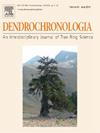Differential responses of pinaceae and cupressaceae tree radial growth to drought in Central Asia
IF 2.7
3区 农林科学
Q1 FORESTRY
引用次数: 0
Abstract
Global climate change is increasing the intensity and frequency of compound hot-drought events, with many negative impacts on forest ecosystems. The dynamics of tree growth recovery after compound hot-drought events and the factors influencing it are unclear. Therefore, we collected data on a total of 101 tree ring widths of eight tree species in Central Asia, which were categorized into two main groups, Pinaceae and Cupressaceae. We first quantified tree growth loss during drought and growth recovery after drought, and then linear mixed models assessed factors affecting tree growth recovery. The results showed that after a compound hot-drought event, Pinaceae radial growth declined more and took longer to recover, while Cupressaceae radial growth declined less and recovered quickly. There was a significant downward trend in growth loss during drought as tree pre-drought growth levels increased. Tree growth recovery tended to increase as both pre-drought growth levels and post-drought wetness increased, and higher pre-drought growth levels were required for Pinaceae to return to normal growth levels after a compound hot-drought event. Linear mixed modeling results showed greater contribution of pre-drought growth levels and growth loss to growth recovery. Thus, Cupressaceae was able to better adapt to compound heat-drought events, while higher pre-drought growth levels and post-drought wetness were key to increased growth recovery.
中亚松科和柏科树木径向生长对干旱的差异响应
全球气候变化增加了复合热旱事件的强度和频率,对森林生态系统产生了许多负面影响。复合干热事件后树木生长恢复的动态及其影响因素尚不清楚。因此,我们收集了中亚8种树种的101个树木年轮宽度数据,将其分为松科和柏科两大类。我们首先量化了干旱期间树木的生长损失和干旱后树木的生长恢复,然后用线性混合模型评估了影响树木生长恢复的因素。结果表明:复合热旱事件后,松科植物径向生长下降幅度较大,恢复时间较长;柏科植物径向生长下降幅度较小,恢复速度较快;干旱期间树木生长损失呈显著下降趋势,干旱前树木生长水平增加。随着干旱前生长水平和干旱后湿度的增加,树木的生长恢复都有增加的趋势,并且在复合热干旱事件后,松科植物需要更高的干旱前生长水平才能恢复正常生长水平。线性混合模拟结果显示,干旱前的生长水平和生长损失对生长恢复的贡献更大。因此,柏科植物能够更好地适应复合热干旱事件,而较高的干旱前生长水平和干旱后的湿度是促进生长恢复的关键。
本文章由计算机程序翻译,如有差异,请以英文原文为准。
求助全文
约1分钟内获得全文
求助全文
来源期刊

Dendrochronologia
FORESTRY-GEOGRAPHY, PHYSICAL
CiteScore
5.50
自引率
13.30%
发文量
82
审稿时长
22.8 weeks
期刊介绍:
Dendrochronologia is a peer-reviewed international scholarly journal that presents high-quality research related to growth rings of woody plants, i.e., trees and shrubs, and the application of tree-ring studies.
The areas covered by the journal include, but are not limited to:
Archaeology
Botany
Climatology
Ecology
Forestry
Geology
Hydrology
Original research articles, reviews, communications, technical notes and personal notes are considered for publication.
 求助内容:
求助内容: 应助结果提醒方式:
应助结果提醒方式:


